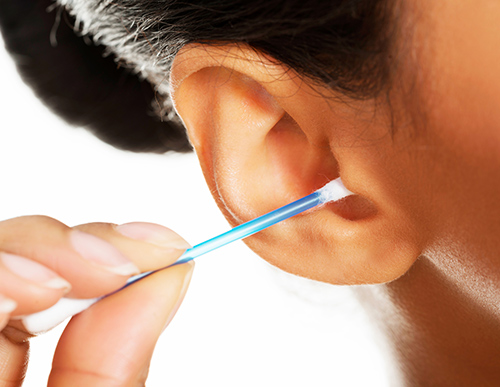
Do you remember your grandmother telling you never to stick anything smaller than your elbow into your ear (and then you actually tried to do it)? Turns out your grandmother was right. Everyone from your local hearing care professional to the American Academy of Otolaryngology-Head and Neck Surgery (AAO-HNS)—and even that box of swabs in your bathroom—all back her up on this one. Here are 5 surprising reasons you can cross ear wax removal off of your daily hygiene regimen list:
1. You Don’t Need to Clean Your Ears
Nature formulated cerumen, the technical word for ear wax, to clean your ears all by itself. Cerumen grabs dust and debris before it travels deeper into your ear canal where it could possibly get trapped. The ordinary daily mechanics of just talking, chewing and yawning actually moves ear wax down and out of the ear canal so you don’t have to do anything else, really. Using a swab, fork, key, finger, chopstick, pencil or any other foreign implement for ear wax removal actually reverses your ears’ self-cleaning process, pushing used ear wax deeper into the canal where it can get impacted and lead to injury and hearing loss.
2. Ear Wax is Your Friend
Sure, cerumen may look dodgy, but your ears know what they’re doing by making it. Ear wax has several health benefits aside from moving the dirt out of your ears. It protects your ears against fungal infections, viruses, bacteria, and even deters insects! It also protects and lubricates the inside of the ear canal to keep it healthy.
You have glands inside of your ears programmed for mixing up a special recipe of cholesterol, fatty acids, enzymes, alcohols, sebum, sloughed off skin cells, and other chemicals—the end result is ear-protecting ear wax. In fact, average cerumen is slightly acidic—which inhibits fungal and bacterial growth. Yay ear wax!
3. Ear Cleaning Hearing Loss is a Real Thing
If you’ve been using swabs to clean your ears for years (like millions of other people), it’s entirely possible that you’ve impacted old ear wax into your ear canal, which means you might have sustained some hearing loss already. Schedule an appointment with your hearing care professional for a hearing checkup to determine whether or not you have impacted ear wax that might be causing some amount of hearing loss.
On the other hand, some people do actually make excess ear wax, and some people make too little. Sometimes the chemical composition of the ear wax isn’t ideal—it may be too dry or too wet, making it hard for the cerumen to do its job correctly. Either way, it’s still a bad idea to use anything bigger than your elbow for ear wax removal. If you have any concerns about your ears’ cerumen production, again, please schedule an appointment with your hearing care professional.
Now, if you need to wear hearing aids, you do need to pay attention to ear wax buildup and proper ear cleaning because sometimes that can impact ear wax into the ear canal. But still—no swabs! That’s why it’s so important to follow your hearing care professional’s recommendations on gentle ear washing and regular cleaning of your hearing aids to keep the balance right and your hearing healthy.
4. Ear Cleaning Injuries to Avoid…
Every year, 12,500 American children have to go to the doctor from ear cleaning injuries. Millions of parents still think that ear cleaning is as necessary a hygiene item as teeth brushing. But often the kids do it to themselves. The most common of these injuries include tympanic membrane tears (torn ear drum) or other small cuts and lacerations inside the ear canal.
And then there’s the “all natural” practice of “ear candling” that you should absolutely avoid. Billed as a “natural ear wax removal” technique, you basically stick a hollow, cone-shaped candle into your ear canals and light it. Thousands of people go to the doctor with ear candling injuries every year too. Here’s what you need to know about ear candling:
- It’s been proven ineffective for ear cleaning and can actually make ear wax impaction worse.
- It causes burn injuries to the face, ears, hair, etc. – even burns that go all the way to the ear drum and middle ear.
- It’s also been known to puncture the ear drum.
So no ear candling for you!
5. A Regular Shower is All Your Ears Really Need
All you really need to do is gently dab your ears dry with a towel after your daily shower and hair washing routine. Normally, this is entirely sufficient for healthy ear cleaning. But if you have any concerns about your ear health, excess ear wax, impaction, ear injury or hearing loss, schedule an appointment with your hearing care professional today for appropriate care – and be a little more thankful for that hard-working ear wax!
